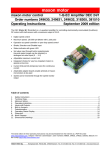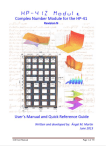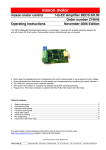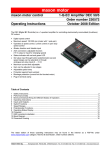Download Operating Instructions
Transcript
maxon motor maxon motor control Operating Instructions 1-Q-EC Amplifier AECS 35/3 Order number 215738 April 2006 Edition The AECS (Analogue EC Controller Sensorless) is a 1-quadrant EC amplifier for controlling electronically commutated (brushless) DC motors. Rotor position sensors (Hall sensors) are not required. • • • • • • • • • • The electronics are flexible to use due to their wide input voltage range (8 - 35 VDC). A fixed current limitation restricts motor current to 5 A max. Motor speed is regulated and if required, can be adjusted by the built-in potentiometer or an externally predetermined set value. Speed can be monitored through the speed monitor output. A “Brake” input allows the motor shaft to slow down to a halt. The „Direction” input adjusts motor direction. The “Disable” input can interrupt the power supply to the motor. Motor connection either by using screw terminals or flex print connector (for maxon flat motors). The current rotor position is evaluated by using the back-EMF sensing technique. The integrated power MOS-FET power stage produces a high efficiency level. Table of contents 1 2 3 4 5 6 7 8 9 Safety Instructions ........................................................................................................................................... 2 Performance Data............................................................................................................................................ 3 Minimum External Wiring................................................................................................................................. 4 Operating Instructions...................................................................................................................................... 6 Functions and Signals ..................................................................................................................................... 7 Inputs and Outputs .......................................................................................................................................... 9 Pin assignment .............................................................................................................................................. 15 Block Diagram ............................................................................................................................................... 17 Dimension Drawing........................................................................................................................................ 17 The latest edition of these operating instructions may be downloaded from the internet as a PDF-file under www.maxonmotor.com, category «Service & Downloads», Order number 215738. maxon motor 1-Q-EC Amplifier AECS 35/3 sensorless Operating Instructions 1 Safety Instructions Skilled Personnel Only experienced, skilled personnel should install and start the equipment. Statutory regulations The user must ensure that the amplifier and the components belonging to it are assembled and connected according to local statutory regulations. Load disconnected For initial operation, the motor should be free running, i.e. with the load disconnected. Additional safety equipment Any electronic apparatus is, in principle, not fail-safe. Machines and apparatus must therefore be fitted with independent monitoring and safety equipment. If the equipment breaks down, if it is operated incorrectly, if the control unit breaks down or if the cables break, etc., it must be ensured that the drive or the complete apparatus is kept in a safe operating mode. Repairs Repairs may only be carried out by authorised personnel or the manufacturer. It is dangerous for the user to carry out any repairs. Danger Ensure that no apparatus is connected to the electrical supply during installation of the AECS 35/3. After switching on, do not touch any live parts! Wiring procedure All cable connections should only be connected or disconnected when the power is switched off. Max. supply voltage Make sure that the supply voltage is between 8 and 35 VDC. Voltages higher than 35 VDC or of wrong polarity will destroy the unit. Start-up procedure Start-up problems may occur in unfavourable applications through the principle of sensorless commutation. This is the case with high friction torque, a very high load moment of intertia and in general, applications of flat motors operated at high voltages (above motor’s nominal voltage). Electrostatic sensitive device (ESD) 2 maxon motor control April 2006 Edition / Subject to change maxon motor Operating Instructions 1-Q-EC Amplifier AECS 35/3 sensorless 2 Performance Data 2.1 Electrical data Supply voltage VCC ....................................................................................................... 8 - 35 VDC Continuous output current Icont .................................................................................................. 3 A Max. output current Imax (limited internally) ............................................................................... 5 A Switching frequency of power stage .............................................................................typ. 40 kHz Speed range (motor with 1 pole pair)........................................................ typ. 1000 ... 90 000 rpm 2.2 Inputs Direction ........................................................................... logic signal (5 V) or switch against Gnd Open or high level = clockwise at Gnd = counter-clockwise Brake ................................................................................ logic signal (5 V) or switch against Gnd Open or high level = motor shaft turns at Gnd = motor shaft stops Disable................................................................................................................. logic signal (5 V) Open or low level = motor shaft turns High level = motor is separated from supply Set value...............................................................................................analogue input (0.8 ... 5 V) 2.3 Outputs Monitor n................................................................... open collector (pull-up 22 kΩ at 5 V, 10 mA) Speed monitoring NOS............................................ open collector (pull-up 4.7 kΩ at 5 V, 10 mA) Control voltage OUT ............................................................................. analogue output (0 ... 5 V) 2.4 Motor connections Motor winding 1 Motor winding 2 Motor winding 3 2.5 Ambient temperature / humidity range Operation.......................................................................................................................0 ... +40°C Storage ...................................................................................................................... -40 ... +85°C No condensation........................................................................................................... 20 ... 80 % 2.6 Mechanical data Weight ........................................................................................................................approx. 20 g Dimensions (L x W x H) ....................................................................................... 74 x 51 x 20 mm Fastening.................................................................4 distance pins hexagonal M3 internal thread Mounting hole separation ...................................................................................... 63.2 x 40.6 mm 2.7 Terminals Power / Signal Screw terminals J1 ............................................................................................................. 9 poles Pitch .................................................................................................................................2.54 mm AWG 26-20 .......................................................................................................... 0.14 ... 0.5 mm2 Motor terminal Screw terminals J2 ............................................................................................................. 3 poles Pitch .................................................................................................................................2.54 mm 2 AWG 26-20 .......................................................................................................... 0.14 ... 0.5 mm Flex print connector J3 ....................................................................................................... 4 poles Pitch ...................................................................................................................................1.0 mm April 2006 Edition / Subject to change maxon motor control 3 maxon motor 1-Q-EC Amplifier AECS 35/3 sensorless Operating Instructions 3 Minimum External Wiring 3.1 Power Supply / Motor Application with maxon EC motor Application with maxon EC Flat motor 4 maxon motor control April 2006 Edition / Subject to change maxon motor Operating Instructions 3.2 1-Q-EC Amplifier AECS 35/3 sensorless Set value input with internal potentiometer P1 with external potentiometer with external set value +0.8 … +5 V April 2006 Edition / Subject to change maxon motor control 5 maxon motor 1-Q-EC Amplifier AECS 35/3 sensorless Operating Instructions 4 Operating Instructions 4.1 Power supply layout Any available power supply can be used, as long as it meets the minimum requirements set out below. During set up and adjustment phases, we recommend separating the motor mechanically from the machine to prevent damage from uncontrolled motion. Power supply requirements Output voltage Ripple Output current VCC min. 8 VDC; VCC max. 35 VDC <5% depending on load, continuous max. 3 A acceleration, short-time max. 5 A The required voltage can be calculated as follows: Known values: • Operating torque MB [mNm] • Operating speed nB [rpm] • Nominal motor voltage UN [V] • Motor no-load speed at UN, n0 [rpm] • Speed/torque gradient of motor ∆n/∆M [rpm/mNm] Sought values: • Supply voltage VCC [V] Solution: Vcc = UN ∆n ⋅ ( nB + ⋅ M B ) + 1.5V n0 ∆M Choose a power supply that can supply this calculated voltage under load. The formula takes account of a 1.5 max. voltage drop at power stage. What speed do I reach with my power supply: ⎡ n n B = ⎢(VCC − 1.5 V ) ⋅ 0 UN ⎣ ⎤ ⎡ ∆n ⎤ ⋅MB⎥ ⎥−⎢ ⎦ ⎦ ⎣ ∆M Note: Please note chapter 6.1.2, „Brake” when using the “Brake” input! 6 maxon motor control April 2006 Edition / Subject to change maxon motor Operating Instructions 4.2 1-Q-EC Amplifier AECS 35/3 sensorless Pre-adjustment With the pre-adjustment, the potentiometers are set in a preferred position. AECS units in the original packing are already pre-set. P1 JP1 JP2 Pre-adjustment Speed Speed range Speed mode 50% open open 5 Functions and Signals 5.1 Start-up procedure Depending on the rotor start position and size of the coupled load, there is a short build-up procedure prior to the motor’s run-up. During the start-up procedure, the motor shaft may temporarily make right-left rotary motions! The following points are detrimental to the start-up procedure: • high friction torque • very high load moment of intertia • high voltages (above motor’s nominal voltage) Note: Start-up problems may occur in unfavourable applications through the principle of sensorless commutation. Multipole motors (maxon EC flat motors) should only be run with a closed JP1 built-in jumper, otherwise the control amplification would be too high and the speed controller starts to oscillate. This behavior is particularly noticeable in maxon flat motors. (VCC > motor nominal voltage) 5.2 Current limitation The AECS’s current limitation is around 5 A, in which operation is permissible during max. 20 s. The maximum continuous current is 3 A, otherwise thermal overload would occur. The AECS’s power stage and motor are not protected against thermal overload. April 2006 Edition / Subject to change maxon motor control 7 maxon motor 1-Q-EC Amplifier AECS 35/3 sensorless 5.3 Operating Instructions Speed range, Jumper JP1 The maximum speed is limited by the supply voltage and the speed that can be best adjusted at the set value input. Jumper JP1 allows two speed ranges: Motor with 1 pole pair Maximum speed Motor with 4 pole pairs Motor with 8 pole pairs open 12 000 rpm 3 250 rpm 1 625 rpm closed 90 000 rpm 22 500 rpm 11 250 rpm Jumper JP1 Important: Some motor types allow only one speed range. See maxon catalogue “Max permissible speed”. Multipole motors (maxon EC flat motors) should only be operated with a closed JP1 built-in jumper, otherwise the control amplification would be too high and the speed controller would start to oscillate. The motor voltage cannot be reduced to 0 V because of the commutation process, therefore the motor must be operated at a minimum speed, depending on operating voltage, load and motor type. The minimum speed is determined by the speed constants and minimum motor voltage. The AECS’s minimum motor voltage is around 10% of operating voltage. Example: VCC = 24 V, kn = 195 rpm V-1 => Motor voltage UM = 2.4 V, nmin = approx. 500 rpm 5.4 Speed mode, Jumper JP2 Speed control is deactivated by closing jumper JP2. The motor turns with the maximum speed. 8 maxon motor control Jumper JP2 Speed mode open Speed control (closed loop) closed True commutation April 2006 Edition / Subject to change maxon motor Operating Instructions 1-Q-EC Amplifier AECS 35/3 sensorless 6 Inputs and Outputs 6.1 6.1.1 Inputs „Direction“ The motor shaft’s direction is predetermined through the „Direction” input. Input voltage range Input current Overvoltage protection 0 ... +5 V max. -200 µA (internal current source at +5 V) not protected Clockwise (CW) Counter-clockwise (CCW) Input open or input voltage > 4.0 V Set input to Gnd or input voltage < 1.0 V Wiring examples: Switch Relay contact NPN transistor Optocoupler Clockwise (CW) Switch open Contact open Counter-clockwise (CCW) Switch closed Contact closed April 2006 Edition / Subject to change Transistor blocked IC = 0 Transistor conductive IC = 200 µA Transistor blocked IC = 0 Transistor conductive IC = 200 µA Logic component HIGH Level > 4.0 V LOW Level < 1.0 V maxon motor control 9 maxon motor 1-Q-EC Amplifier AECS 35/3 sensorless 6.1.2 Operating Instructions „Brake“ If the input is not wired or the applied voltage is greater than 4.0 V, the brake function is deactivated. If the input is placed at Gnd-potential or the applied voltage is lower than 1.0 V, the brake function is activated and the motor shaft slows down to a halt, shortcircuiting the motor windings. The motor windings remain short-circuited until the brake function is deactivated. Input voltage range Input current Overvoltage protection 0 ... +5 V max. -200 µA (internal current source at +5 V) Not protected Brake function not active Brake function aktive Input open or input voltage > 4.0 V Set input to Gnd or input voltage < 1.0 V Wiring examples: Switch Relay contact Brake function not active Switch open Contact open Brake function active Switch closed Contact closed NPN transistor Optocoupler Logic component Transistor blocked IC = 0 Transistor conductive IC = 200 µA HIGH Level > 4.0 V Transistor blocked IC = 0 Transistor conductive IC = 200 µA LOW Level < 1.0 V The maximum permitted brake speed is limited by the maximum permitted short-circuit current and maximum kinetic energy: • I <= 10 A • Wk <= 20 Ws The values can be calculated as follows: The maximum permitted brake speed can be calculated from the motor data: nmax = 10 A ⋅ k n ⋅ (RPh− Ph + 0.13Ω) [rpm] max. permitted brake speed -1 limited by brake kn = Speed constant [rpm V ] current (I = 10 A) RPh-Ph = Terminal resistance phase-phase [Ω] • With the given moment of inertia, the maximum speed can be determined using the following formula: max. permitted brake speed limited by kinetic energy nmax = (Wk = 20 Ws) 365 ⋅ 10 000 JR + JL [rpm] JR = Rotor inertia [g cm2] JL = Load inertia [g cm2] • • 10 maxon motor control April 2006 Edition / Subject to change maxon motor Operating Instructions 6.1.3 1-Q-EC Amplifier AECS 35/3 sensorless „Disable“ Enable or disable the power stage. If the input "Disable" is not wired or placed at Gnd-potential or the applied voltage is lower than 0.4 V, the amplifier is activated. If the applied voltage is greater than 2.4 V, the power stage is blocked and the motor shaft freewheels and slows down. The “Disable” input is protected against overvoltage. Input voltage range Input impedance Max. input voltage Power stage active Power stage inactive 0 ... +24 VDC approx. 6 kΩ resistance against Gnd 0 ... +25 VDC Input open or set to Gnd or input voltage < 0.4 V Input voltage > 2.4 V Wiring examples: a) switch open = „Enable“; switch closed = „Disable“ Switch Relay contact NPN transistor Optocoupler Power stage active Motor winding fed with current Power stage inactive Motor shaft freewheels and slows down Switch open Switch closed Contact open Contact closed Transistor blocked IE = 0 Transistor conductive IE > 0 Logic component Transistor LOW Level blocked IE = 0 Transistor con- HIGH Level ductive IE > 0 b) switch open = „Disable“; switch closed = „Enable“ Switch Relay contact NPN transistor Optocoupler Power stage active Motor winding fed with current Power stage inactive Motor shaft freewheels and slows down Calculation help Switch closed Switch open Contact closed Contact open Known value: +Vext = +3.3 … +24 VDC Sought value: ⎞ ⎛ V Transistor conductive IC > 0 Transistor blocked IC = 0 Rext ≤ ⎜⎜ ext ⋅ 6000 Ω ⎟⎟ − 6000 Ω ⎠ ⎝ 2.4 V April 2006 Edition / Subject to change Transistor conductive IC > 0 Transistor blocked IC = 0 [Ω] maxon motor control 11 maxon motor 1-Q-EC Amplifier AECS 35/3 sensorless 6.1.4 Operating Instructions “Set value” Set value input via external power supply The voltage at the “Set value” input predetermines the speed set value. The speed changes proportionately to the set value. Input voltage range Input impedance Overvoltage protection 0.8 ... +5 V (reference against Gnd) > 1M Ω not protected Set value input via internal potentiometer P1 The “Set value” input (J1, clamp 6) must be connected to the „Control voltage OUT” output (J1, clamp 7). Note: The lower and upper limitation of speed adjustment must be observed (see chapter 5.3, “Speed range, Jumper JP1”). Set value input via external potentiometer Internal potentiometer P1 at right end stop Value of external potentiometer 100 kΩ 12 maxon motor control April 2006 Edition / Subject to change maxon motor Operating Instructions 6.2 6.2.1 1-Q-EC Amplifier AECS 35/3 sensorless Outputs „Control voltage OUT“ If the internal potentiometer P1 is used for speed adjustment, the “Control voltage OUT” output (clamp 7) must be electrically connected to the „Set value” input (clamp 6). 6.2.2 Output voltage range Output impedance 0 ... +5 V approx. 10 kΩ Potentiometer P1 right end stop Potentiometer P1 left end stop +5 VDC 0V Speed monitor „NOS“ The NOS output (Non Operating Signal) can be used for status monitoring. Output voltage range Output current 0 ... +5 V max. 10 mA against Gnd Voltage value 'low' Motor shaft turns max. 0.3 V Motor shaft stops +5 V (4.7 kΩ internal pull-up resistor at +5 V) Voltage value 'high' Note: Cable failure or lack of supply voltage cannot be monitored! 'High' level is displayed during the motor’s start-up cycle. April 2006 Edition / Subject to change maxon motor control 13 maxon motor 1-Q-EC Amplifier AECS 35/3 sensorless 6.2.3 Operating Instructions „Monitor n“ The motor shaft’s set speed can be monitored at the electronics „Monitor n” output. The set speed is available as a digital signal (high/low) and corresponds to half the commutation frequency. Output voltage range Output current 0 ... +5 V max. 10 mA against Gnd Voltage value 'low' Voltage value 'high' max. 0.3 V +5 V (22 kΩ internal pull-up resistor at +5 V) Sought: frequency at the „Monitor n” output f Monitor n = n set ⋅ z Pol 20 [ Hz ] nset = Speed [rpm] zPol = Number of the motor’s pole pairs Sought: motor shaft speed n set = f Monitor n ⋅ 20 z Pol [rpm] fMonitor n = Frequency at the „Monitor n” output [Hz] zPol = Number of the motor’s pole pairs 14 maxon motor control April 2006 Edition / Subject to change maxon motor Operating Instructions 1-Q-EC Amplifier AECS 35/3 sensorless 7 Pin assignment 7.1 Pin assignment J1 Power / Signal 9 8 7 6 5 4 3 2 1 Screw terminal Pitch AWG 26-20 7.2 Monitor n Speed monitoring NOS Control voltage OUT Set value Disable Brake Direction Gnd +VCC 8 … 35VDC 9 poles 2.54 mm 0.14 ... 0.5 mm2 Pin assignment J2 motor connection 1 2 3 Screw terminal Pitch AWG 26-20 Note: Motor terminals matching, e.g: April 2006 Edition / Subject to change Motor winding 1 Motor winding 2 Motor winding 3 3 poles 2.54 mm 0.14 ... 0.5 mm2 maxon EC motor maxon EC motor maxon EC motor maxon EC motor EC∅16 sensorless EC∅22 sensorless EC∅32 EC∅40 maxon motor control 15 maxon motor 1-Q-EC Amplifier AECS 35/3 sensorless 7.3 Operating Instructions Pin assignment J3 (4 poles flex print connector) 1 2 3 4 Flex print connector Pitch Note: Motor terminals matching, e.g: 16 maxon motor control Motor winding 1 Motor winding 2 Motor winding 3 Neutral point Y (not used) 4 poles, top contact style 1.0 mm maxon EC∅14 Flat motor sensorless maxon EC∅20 Flat motor sensorless maxon EC∅32 Flat motor sensorless maxon EC∅45 Flat motor sensorless April 2006 Edition / Subject to change maxon motor Operating Instructions 1-Q-EC Amplifier AECS 35/3 sensorless 8 Block Diagram 9 Dimension Drawing Dimensions in [mm] April 2006 Edition / Subject to change maxon motor control 17



























